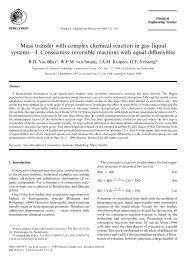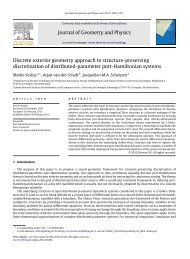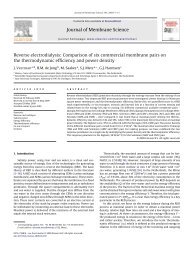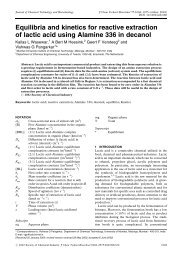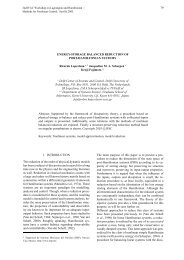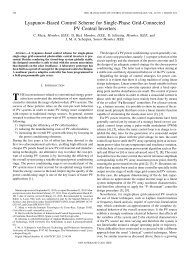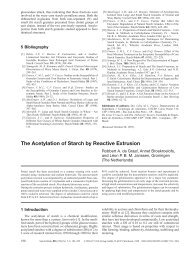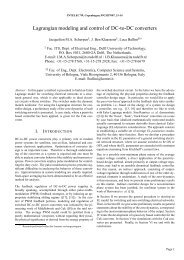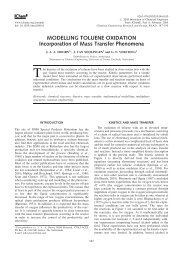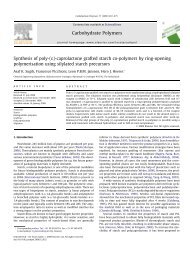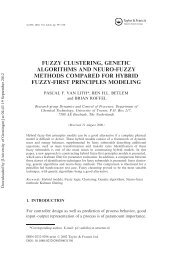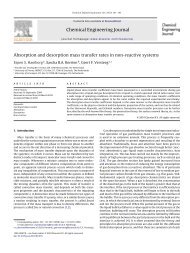Reverse electrodialysis: evaluation of suitable electrode systems - ITM
Reverse electrodialysis: evaluation of suitable electrode systems - ITM
Reverse electrodialysis: evaluation of suitable electrode systems - ITM
You also want an ePaper? Increase the reach of your titles
YUMPU automatically turns print PDFs into web optimized ePapers that Google loves.
1466 J Appl Electrochem (2010) 40:1461–1474RED is much lower; Veerman et al. reported 4 mA cm -2for their experiments whereas an improvement with afactor 5 is expected in the future with high performancemembranes and spacers [1].Advantages <strong>of</strong> carbon <strong>electrode</strong>s to Ti/Ru/Ir <strong>electrode</strong>sare:– No use <strong>of</strong> exhaustible precious metals.– High overpotentials for gas formation.There is no risk <strong>of</strong> evolvement <strong>of</strong> dangerous andaggressive gasses (H 2 ,O 2 and Cl 2 ). Even with a reversibleredox couple this may be the case if the flow <strong>of</strong> the <strong>electrode</strong>rinse solution is obstructed locally.A disadvantage <strong>of</strong> graphite may be the lower mechanicalstability with respect to DSA-type <strong>electrode</strong>s during longeroperation times and the need for a proper current collectingsystem. Therefore, graphite <strong>electrode</strong>s may be advantageousfor the Fe 2? /Fe 3? system as well as for the[Fe(CN) 6 ] 4- /[Fe(CN) 6 ] 3- system. We added such <strong>systems</strong>to Table 3 (column 11 and 12). The rather good end scoresencourages further research on these <strong>systems</strong>.2.4 Symmetry in RED stacksIf the sea and river water inlets <strong>of</strong> a RED stack are interchanged,the polarity <strong>of</strong> the generated voltage is reversed.Consequently, the performance <strong>of</strong> the RED stack is unalteredif the generating system (GS) and the <strong>electrode</strong> system(ES) are both symmetrical. It is evident that thesymmetrical properties <strong>of</strong> GS and ES are related.2.4.1 Reversal <strong>of</strong> the electrical currentFor some <strong>electrode</strong> <strong>systems</strong> periodical reversal is obligatoryas for <strong>systems</strong> with participating (one dissolving andone growing) <strong>electrode</strong>s. These <strong>electrode</strong> <strong>systems</strong> aredesignated as ‘obligatory reversal’ or ES 1 . Other <strong>systems</strong>consist <strong>of</strong> ‘universal’ <strong>electrode</strong>s where reversal is possiblebut not obligatory and are called ‘facultative reversal’ orES 2 . A third case consists <strong>of</strong> the specific <strong>electrode</strong>s that areonly <strong>suitable</strong> as cathode or as anode and in which reversal<strong>of</strong> the electrical current is not possible. These are denotedas forbidden interchange or ES 3 .2.4.2 Interchange <strong>of</strong> the feed water in RED stacksJust as with the <strong>electrode</strong> system, we distinguish for thegenerating system between three types:GS 1 : obligatory interchangeIn RED, growth <strong>of</strong> microorganisms in the stacks may bea serious problem. One approach to prevent this, is theperiodical interchange <strong>of</strong> the river and sea water inputs. Acomparable method is used for normal <strong>electrodialysis</strong> fordesalination purposes and is called ‘<strong>electrodialysis</strong> reversal’(EDR) [28, 29]. From experiments in the future, it maybe proven that such a procedure is necessary and we denotethis system as ‘obligatory interchange’’ or as GS 1 .GS 2 : facultative interchangeIf it should be proved that feed water interchange is notbeneficial for prevention <strong>of</strong> microbial growth or forbreaking down polarization layers, then this interchange isnot obligatory. If, besides that, the GS is symmetrical (withidentical sea and river water compartments), the interchange<strong>of</strong> sea and river water is also not forbidden. In thiscase we have a ‘facultative interchange’ system or GS 2 .GS 3 : forbidden interchangeBottlenecks in stack design for RED are the hydrodynamicalfluid resistance in all compartments and electricalresistance in river water compartments [1]. Optimizationcan lead to an asymmetric stack: sea water compartmentsmay be thicker than river water compartments to reducehydrostatic resistance without affecting electrical resistancesubstantially; also length and width can differ. Insuch a stack interchanging sea and river water is possiblefor cleaning purposes but during this interchange the powerproduction is low. We call this a ‘forbidden interchange’system GS 3 ; although the adjective forbidden should not tobe interpreted strictly.2.5 Voltage losses in <strong>electrode</strong> <strong>systems</strong>Electrode <strong>systems</strong> introduce a voltage loss in the REDsystem due to an overpotential, concentration polarization,an ohmic potential and a Nernst potential in each <strong>electrode</strong>compartment. In RED, current densities are relatively low(in our own experiments about 4 mA cm -2 [1]) and thelosses due to concentration polarization and the ohmicpotential are minimal. This is a general property <strong>of</strong> allstudied <strong>electrode</strong> <strong>systems</strong> for RED. Further, with respect tovoltage losses, these <strong>systems</strong> can be divided in low, highand medium loss <strong>electrode</strong> <strong>systems</strong>.Low loss In <strong>systems</strong> with opposite <strong>electrode</strong> reactionsand a recirculating <strong>electrode</strong> rinse, there is no net chemicalreaction and the Nernst voltages on both <strong>electrode</strong>s canceleach other. In most <strong>of</strong> these <strong>systems</strong> no gas reactions areinvolved and the overpotentials are low. The total voltageloss in the whole <strong>electrode</strong> system is about 0.1 V; which iscomparable to the generated voltage <strong>of</strong> 1-2 cells.High loss Electrode <strong>systems</strong> with gas evolution havehigher voltage losses. For the electrolyses <strong>of</strong> water, theneeded voltage based on the Nernst equation is 1.23 V, andthe overpotentials are 0.03 V for H 2 and 0.52 V for O 2evolution at a current density <strong>of</strong> 10 mA cm -2 [30], together1.78 V. Because the typical cell voltage is about 60 mVunder power generating circumstances, a number <strong>of</strong> 30 cellsis used to overcome the voltage loss <strong>of</strong> this <strong>electrode</strong> system.123



